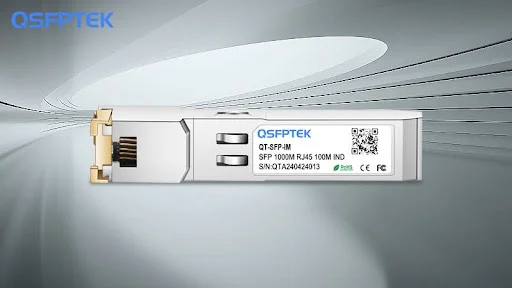In the networking world, 1G copper SFP modules, often referred to as 1G RJ45 SFP transceivers, are a vital component for achieving Gigabit Ethernet over standard copper cabling. Compact, hot-swappable, and versatile, they connect network switches, routers, or media converters to copper Ethernet links, making them a popular choice in diverse settings ranging from office LANs to industrial automation systems. However, not all 1G copper SFP modules are designed for the same operating conditions. Two main categories dominate the market: commercial-grade and industrial-grade. At a glance, they may look identical, but their internal construction, durability, and environmental tolerance vary significantly. Understanding these differences is essential for ensuring network stability and cost efficiency.
Understanding 1G Copper SFP Modules
A 1G SFP module is a compact transceiver that delivers 1 Gbps connectivity, commonly using fiber optic cables for long-distance, low-loss data transmission. These optical modules are ideal for links spanning hundreds of meters or more. For shorter runs or existing copper infrastructure, a 1G copper SFP module offers the same form factor but uses standard Ethernet cables such as Cat5e or higher with an RJ45 interface. This makes it easy to mix fiber and copper connections in the same network, providing flexibility and cost savings in offices or data centers. In harsher settings like factories or outdoor sites, however, the copper module’s reliability becomes a key concern.
Commercial-Grade vs. Industrial-Grade: Core Concepts
Commercial-grade 1G copper SFP modules are engineered for standard indoor environments where temperature, humidity, and air quality are well regulated. These conditions are typical in climate-controlled server rooms, enterprise wiring closets, or academic campuses. Designed for stability within a temperature range of 0°C to 70°C, these modules deliver consistent performance without the need for additional environmental protection. Their materials and components are chosen with cost efficiency in mind, as they are not expected to endure exposure to dust, vibration, or extreme temperature shifts. For most office networks, commercial-grade modules are more than sufficient, offering reliable service at an affordable price.
Industrial 1G copper modules, on the other hand, are purpose-built for harsh and unpredictable environments. They are found in manufacturing plants, oil and gas facilities, railway communication systems, outdoor surveillance networks, and other demanding locations. These modules are designed to operate reliably across a much wider temperature range, typically from -40°C to 85°C. They incorporate enhanced protection against dust, moisture, vibration, and electromagnetic interference, using materials and soldering techniques that can withstand prolonged exposure to mechanical and thermal stress. This ruggedized construction comes at a higher cost, but it significantly reduces the likelihood of failure in critical applications where downtime could disrupt operations or compromise safety.
Key Differences in Performance and Design
The differences between the two grades extend beyond temperature tolerance. In an industrial-grade module, every component is selected for durability, from the circuit board to the outer casing. Special coatings may be applied to resist corrosion, and assembly methods are adapted to reduce the impact of constant vibration or sudden shocks. Commercial-grade modules, by contrast, rely on the stability of their surroundings and therefore do not require the same level of engineering resilience. This distinction reflects their respective design priorities: commercial-grade models are optimized for cost and compatibility, while industrial-grade models prioritize resilience and longevity under stress.
The environments in which these two types are deployed illustrate why these design differences exist. In a data center, network hardware is housed in temperature-controlled racks with redundant cooling systems and dust filtration. Here, a commercial-grade 1G copper SFP module will likely function for years without issue. But in an outdoor surveillance system exposed to freezing winters and scorching summers, or in a factory where high levels of vibration and electrical interference are constant, a commercial-grade module could quickly become unstable or fail altogether. Industrial-grade modules thrive in such scenarios because they are engineered to continue operating in conditions far outside the comfort zone of standard networking equipment.
Making the Right Choice
Choosing between industrial-grade and commercial-grade modules involves weighing several factors, but the most critical is the deployment environment. If the network operates in a location with extreme temperatures, high humidity, airborne particles, or significant mechanical stress, the industrial-grade option is the safer investment. It may have a higher purchase price, but it minimizes the risk of costly downtime, emergency replacements, and operational disruptions. In contrast, if the network is in a secure, climate-controlled setting with minimal environmental hazards, a commercial-grade module will provide stable performance at a lower cost, offering better value for such conditions.
It is also worth considering the operational requirements of the network. In some industrial or transportation systems, equipment is expected to run continuously for months or even years without interruption. In these cases, the higher durability of industrial-grade modules pays dividends in reliability and maintenance savings. On the other hand, networks that can tolerate occasional maintenance windows may not need this level of ruggedness, making commercial-grade modules a reasonable choice. Compatibility is another factor, as both grades are available in the same form factor and typically support the same standards, meaning the decision often comes down to environmental resilience rather than interface differences.
Conclusion
While industrial-grade and commercial-grade 1G copper SFP modules perform the same basic function, the conditions in which they are deployed make their differences crucial. Industrial-grade modules are built for resilience, designed to survive in environments that challenge the limits of most electronics. Commercial-grade modules are tailored for stability in controlled settings, offering cost efficiency and reliable performance where environmental stress is minimal. Understanding these distinctions allows network planners to choose the right solution from the outset, ensuring that the network remains stable, efficient, and cost-effective over its entire lifecycle. Whether supporting the smooth operation of an office LAN or keeping an automated production line online, the right choice of module is a small detail that can have a big impact on network reliability.


